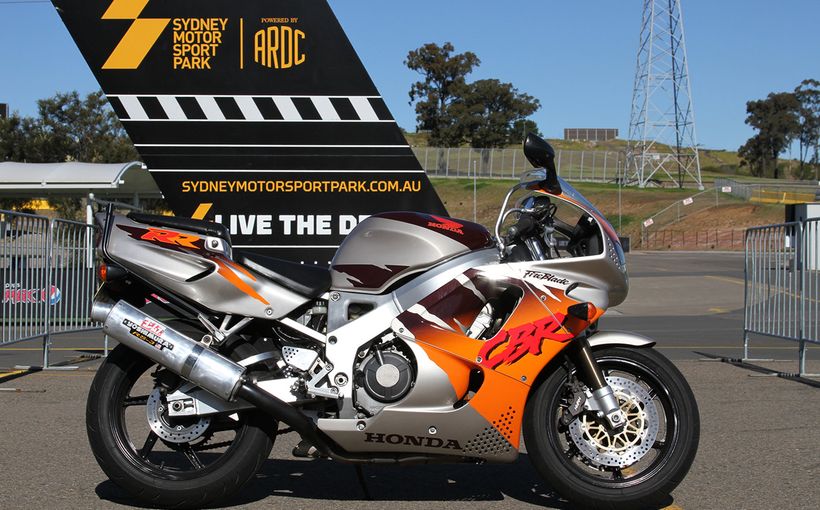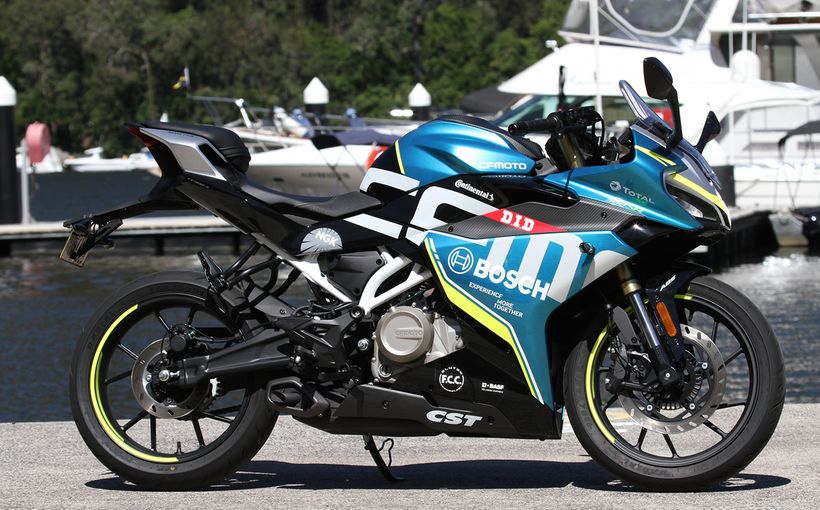In the beginning Gottlieb created - The Einspur

The world’s first motorcycle was a wooden-framed, solid-wheeled device constructed in 1885. Now, there is a faithful replica in Australia.
Just who first thought of the four-stroke engine principle is a matter of some conjecture, with various concepts ranging back to the first patented version by the Italians Eugenio Barsanti and Felice Matteucci in 1854. However, it is generally accepted that in constructing the Otto engine around 1881 from patents lodged five years earlier, German Nikolaus Otto (1832-1891) created the first properly functioning such motor, which was marketed solely as a stationary engine. His machine caught on quickly and was employed in all sorts of industrial situations with the exception of transport. Among Otto’s many employees were Gottleib Daimler and Wilhelm Maybach, both of whom had ideas of adapting the Otto principle to a form of powered transport. At first, they experimented with steam-powered velocipdes, basically motorised versions of the human-powered two, three or four-wheeled bone-shakers of the time, but in 1885 Daimler and Maybach succeeded in building a 264 cc petrol-fired engine on the Otto-cycle principle, and at 80kg was small and light enough (unlike the huge stationary engines) to be fitted into their own design of velocipe and known variously as the Einspur (from Einspurig, or single-track) or the Reitrad (Riding carriage).
The initial problem that the design needed to overcome was how to vaporise gasoline and ignite it rapidly to allow the engine to spin to the required rpm. Daimler’s surface carburettor worked on the principle of having the engine’s piston suck a charge on each stroke, drawing fresh air down the intake pipe. The air bubbled out holes near the bottom of the pipe and up through the gasoline to the surface, which was enclosed by a cylindrical float, in the form of an explosive vapour. This vapour pushed its way out of the cylinder around the edges of the baffle plate, into a reservoir, and then into the cylinder each time the inlet valve opened. A spring-loaded release valve on top of the reservoir opened if a backfire through the carburettor raised the pressure to dangerous levels. The device created explosive vapour quickly, stored it for use, kept the vapour and gasoline separate, and prevented raw gasoline from entering the combustion chamber.

Now for the ignition system. Daimler’s method, arrived at “after endless tests and unremitting pursuit of the objective”, was to insert a thin-walled tube into the cylinder between the valves. The tube was closed on the external end, which was kept red hot by a Bunsen burner. As the piston compressed each charge, part of the mixture entered the hollow tube and was ignited. With the power plant now mobile rather than stationary, the next step was to install it in a chassis.
It was produced by the newly-formed Daimler Motor Company at Stuttgart. Strictly speaking the Einspur was not a single-track at all, because the saddle height was so high that the rider’s feet could not touch the ground, so a set of outrigger wheels was fitted to keep the machine upright. Starting was a complex affair. First the Bunsen burner had to be lit to heat the ignition tube to red hot, then the engine hand-cranked into life. It is reported that the seat caught fire on the first test ride, but did complete a well-publicised test ride of 3 km from Stuttgart-Bad Cannstatt to Unterturkheim and back, ridden by Daimler’s son Paul, on November 10th, 1885. In was in fact, a mobile test bed for a four-wheeled carriage, and it was not long before a water-cooled version of the engine was fitted to a four-wheeled chassis and the Einspur quickly forgotten.
Nevertheless, the Einspur can lay claim to being the first real motorcycle powered by an internal combustion engine, even if its chassis was positively primeval. The main chassis, front fork, wheels and many of the smaller fittings were made from timber, with a boat-style tiller instead of handlebars. The engine was basically all-iron and developed half a horsepower at around 600 rpm. At first, the engine drove straight to a sprocket on the rear wheel via a leather belt, but it was quickly evident that the engine was incapable of turning such high gearing, so a 6:1 reduction system was fitted, driving via toothed bronze cogs. The motor itself had an atmospheric inlet valve and a mechanical exhaust valve, ran on benzine from a surface carburettor and was prone to rapid overheating, hence the pants-searing experience of Daimler Junior en-route to Unterturkheim.

The Einspur led to the Daimler/Maybach universal four-stroke power source, registered with the patent office in April 1885, and designed to ultimately be used in coaches, railway carriages, ships, boats and the nascent aeroplane, as well as for driving pumps and generators. The design quite simply changed the path of history.
With Daimler now firmly focussed on four-wheeled transport, the historic Einspur languished in the factory until 1903, when it, along with many of the company’s prized racing cars, was destroyed by fire at the works. Tragically, not a single photograph of the Einspur is believed to exist, but some of the original drawings were saved. This led to Daimler-Benz commissioning a number of replicas as a project for apprentices to mark the 50th anniversary of the original design. Then on the 100th anniversary, in 1985, Mercedes arranged for eight replicas to be made by Heinz Oppenlaender, mainly to be exhibited at Daimler car showrooms as examples of the company’s ingenuity. Mind you, Oppenlaender, who was a noted builder of working scale models of sea-craft and other mechanical things, had to borrow money to complete the project before he could deliver the replicas to Mercedes. Most of these have survived and can be seen in museums in Europe and USA, but are basically all non-runners due to the complex procedure in actually starting them.
An Aussie Einspur.
Philip Mumenthaler came to Australia from his native Switzerland in 1982 and was naturalised three years later. An electrician by trade, he settled in Kununurra, 850 km south-west of Darwin, just over the Western Australian border, and about as far from Zurich as you can possibly get. He doesn’t see it as that remote. “I can be just about anywhere in three or four days,” Phil says with not a touch of insincerity. And he does. Phil and his white Mercedes van pop up from coast to coast and from top to bottom. When I caught up with him in Bathurst, it was his second trip there in as many months. We met at the National Motor Racing Museum at Mount Panorama one rainy morning. Inside the van was not only his superb Einspur replica, but a pair of Tohatsu 250 cc ‘Hurry’ models from 1959 that he had picked up from Brisbane after buying them sight unseen over the internet.
Phil began his project in 2007, and 1,000 hours and $30,000 later, the Daimler is a living, breathing reality which has now been seen in at the Melbourne Motorcycle Expo and the Vintage Japanese MCC display at Healesville, among other places. “ I think people should see this bike, not (having it) locked away in somebody’s private collection”, he says, hinting that there would be plenty of buyers for such a beautifully-crafted rarity. “I would be happy to have it displayed in museums so people can appreciate just how it (motorcycling) all started. I plan to leave it with the National Motor Museum at Birdwood for the next twelve months or so, then rotate it around other museums.”

The timber used for the chassis is Indonesian Batu, with Tasmanian Oak and hickory in the wheels, with Jarrah hubs. “I did all the little bits,” Phil says modestly, “ but the engine was made by Murray Ferrell, who used to live in Kununurra. The trick was to be able to house everything inside the engine shroud as on the original. A friend in Germany measured one of the Oppenlaender replicas and we went by these dimensions, wheelbase, crankcases, engine height. They used to call this motor the grandfather clock because it is so tall – nearly two feet high – and very advanced for its time. It had fan cooling and a fully-enclosed crankshaft when most engines had open crankshafts. By 1900 Maybach had proper radiators and ignition systems, twin cams, and four-valve heads. The original motor had what they called glow-tube ignition. This was a flame under a platinum tube that was on all the time while the engine was running. The tube had to be heated to cherry red and would go through some sort of asbestos gland into the barrel. To adjust the timing you pushed the tube in and out – if it sticks in further the engine will fire earlier because more hot tube is exposed to the mixture. Pull it out and you retard the ignition.”
“The surface carburettor takes a heated mist mixture – it depended on how many cobblestones you hit as to how rich the mixture was! The carb had no jets – just fumes basically.”
Phil’s engine bristles with home-spun ingenuity, for which he is quick to credit Murray Ferrell and his off-sider Phil McLean. “The crankcases are machined from solid steel, then bronze coated. This is done by pre-heating the cases to 300 degrees and spraying on a primer, then the bronze is sprayed with an air/acetylene mixture. The bronze barrel screws into the crankcase and then the bronze head screws into the top of the barrel, as on the original. We used a modified crankshaft from a Howard Rotivator. The original engine used a face cam on the crankshaft but we modified a cam from a Sundial farm engine. There was so little to go on, no photographs or drawings. It (the Einspur) was built only as an experimental machine, not to be sold to the public, and that’s why there is so little information. Unfortunately Daimler died about the same time as the factory fire that destroyed the bike, so nobody could ask him how it was done – the bike effectively died with him.

Anyway, our engine is externally very similar to the original, and is much easier to start and to actually ride. We used a Honda CBX piston and valves, so with a bore of 64.5 mm and a 100 mm stroke that makes 312 cc instead of the 264 cc original. We use modified electronic ignition with an American Tecumsi carburettor, and we have proper bearings throughout – wheel bearing and steering head – instead of plain bushes. Oppenlaender tested every one of the replicas he built outside his house, and found that they wouldn’t even go up a very slight incline that would be no problem to even a push bike. But the extra performance in this one means it can cope quite OK. It’s also a major effort to get these replicas started, but mine is quite easy. It ran pretty much straight away. You tend to give it too much fuel, but it likes very little. Everything seemed to work the way we meant it to.”
To demonstrate his statement, Phil fired up the Daimler in the car park and did a few laps to the amazement of the assembled visitors to the museum. The starting principle is reasonably straightforward but best handled by two people. After priming the carburettor, a portable drill is attached to the right side crankshaft while the inlet valve is held open, and once the engine spins up, the valve is released and away she goes. Phil points out that the engine runs much sweeter when properly warm, due to the expansion of the engine components effectively reducing the compression ratio. Sure enough, after a slightly erratic initial idling period, it settled down to a regular choof-choof with remarkable mechanical silence. The two speed belt drive gives round 6 km/h in the lower ratio and double that in the higher.
Since its appearance at the 2008 Melbourne Motorcycle Expo, Phil has changed a few things. “The wheel sizes were wrong and the tyres looked too fat. Now the wheels are the correct 620 mm diameter. I have concealed all the ignition stuff under the seat so you don’t see it – all the wires run inside copper tubes so everything is out of sight.”
If you get the opportunity, grab the chance to see the machine that started motorcycling, and a remarkable example of local engineering and craftsmanship. As Phil says with his mixed Swiss/Outback Australian accent, ‘It’s 100% Aussie!”










